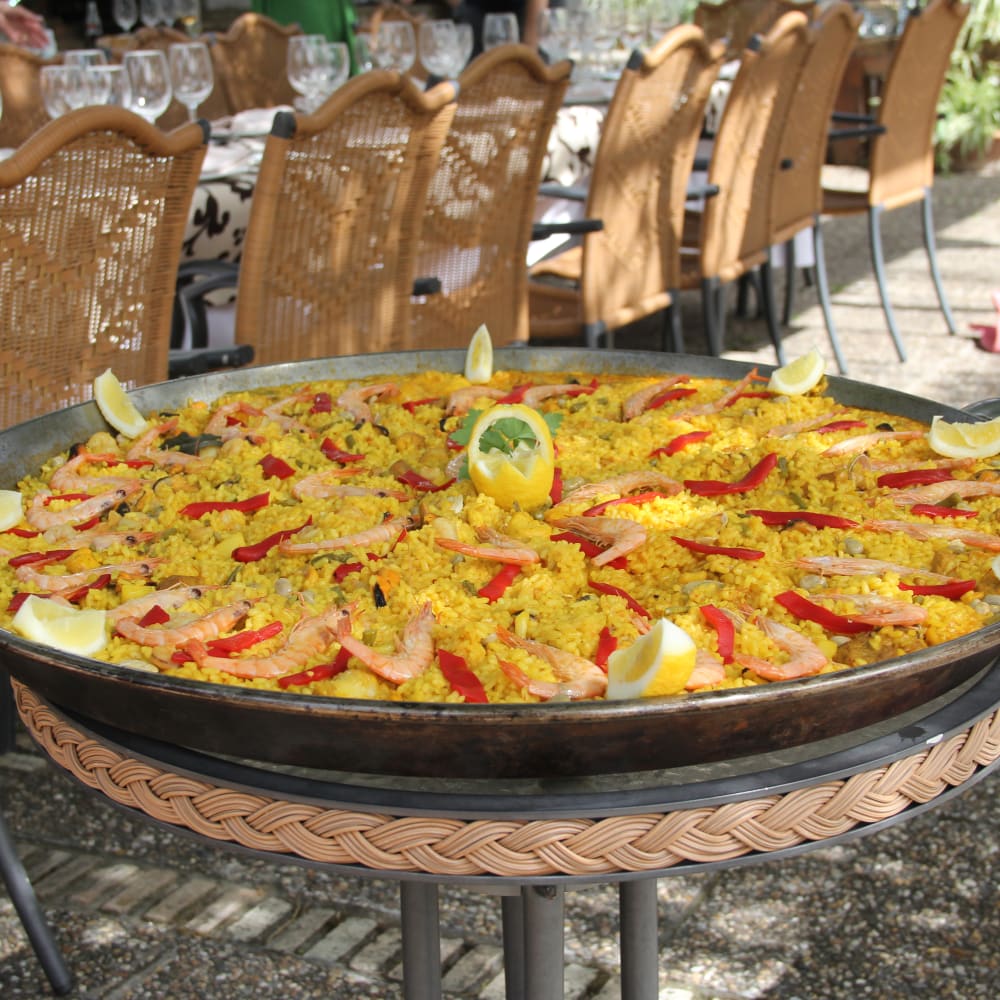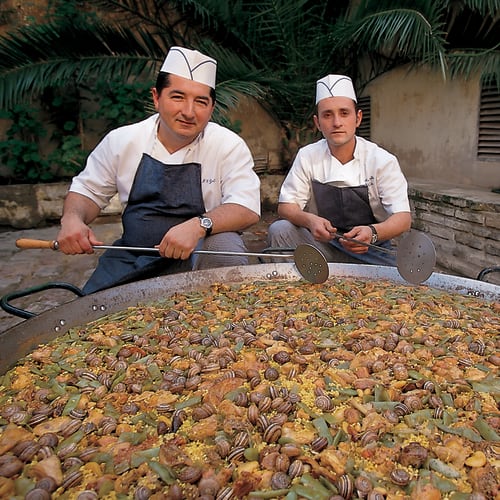It's All About the Rice!
Jonathan Harris | June 2013




What is 'real' paella? I think the soul of paella is about gathering with family and friends in your backyard or at a restaurant, sharing a meal served from a communal pan. The first paellas began as a simple farmer's dish cooked over an open fire. Rice was mixed with whatever was available - vegetables, wild game and even snails. Whatever the ingredients, paella has always been a shared meal, and the process of cooking it is always better when the tasks of preparing it are also shared.
Technically the word 'paella' refers to a pan - broad, shallow, typically steel, used to simmer rice and pasta dishes across southeastern Spain. The meal that we call paella is much more difficult to define.

What passes for paella in most of the world, and in much of Spain, will elicit howls of protest from aficionados in Valencia and beyond. This most famous of Spanish dishes has become the victim of its own popularity, with any combination of meat and saffron colored rice earning the name paella. In fact, most paella is made without real saffron, instead featuring colorante, an inexpensive yellow coloring powder made from turmeric.
Years ago I began a quest to learn how to make truly great paella. Early on I discovered that, even when I fail to cook the rice correctly, or overcook the seafood, I enjoy the adventure of the process, learning about each ingredient and experimenting with new methods make each paella an individual experience to be remembered and built upon.
One of my first lessons was that rice is the heart of any paella. And only one type of rice will produce a great paella, short-grained Spanish rice. Long-grained rice doesn't absorb the flavors of the broth and fluffy short-grained Asian rice ends up sticky. And Italian Arborio is too creamy. The ideal paella rice absorbs the flavor of the broth, yet remains separate and distinct from the grains around it. Bomba is a strain of rice that was saved from oblivion by chefs in Spain about 30 years ago. It is famous for its ability to absorb broth and flavors without breaking apart, and it is a forgiving secret weapon for the home paella chef. Other excellent types of rice for paella are those from Calasparra in Murcia, the bahia and senia rice of Valencia, and rice from the Delta de Ebro near Tarragona.
Another discovery was that not all saffron is created equal. Because this rare spice is so valuable, most saffron is not labeled correctly and is often not saffron at all. We were hoodwinked more than once when we started La Tienda, so we decided to go direct to the source in La Mancha. We now work with Maria Ángeles and Juan Antonio Serrano, a couple who produce saffron in the tiny town of Minaya. There they pick crocus flowers by hand, and pluck the pistils to be toasted on a silk screen. Our orders have helped reinvigorate the saffron industry in the town, with several neighbors joining them in planting crocus bulbs as they had for generations before thereby reviving a way of life that was nearly wiped out by fraud. The resulting saffron is remarkable - aromatic and floral with a beautiful coloring power.
Traveling across Spain, I learned that there are many great rice dishes, with many different names. Most are simply called arrozes, literally ‘rices.’ I enjoyed one of the most sublime examples in Alicante, called Arroz a Banda. My brother and I were visiting one of our olive suppliers and he invited us to a restaurant overlooking the Mediterranean Sea. The waiter presented a paella pan with a thin layer of richly colored rice. No vegetables or seafood were immediately apparent as he spooned the rice onto our plates, but the first bite revealed the magic of this dish. The secret to Arroz a Banda is that the rice contains the essence of dozens of ingredients, including shrimp, fish, calamari, saffron, garlic, peppers and more. What an explosion of flavor! Later the seafood is served apart, or a banda, so you can savor the complex, rich taste of the rice on its own.

This is when I realized that the paella I first learned about, what I like to call Paella Mixta or Paella Americana, is an entirely different dish than traditional rice and paellas. In Spain, paellas are usually focused on one or two main ingredients, and almost never mix seafood and meat. Chorizo is almost unheard of as an ingredient in paella. The focus is on the rice, flavored with a great broth - any seafood or meat is almost like a garnish for the beautifully cooked rice.
There is something wonderfully American about the paella we most often find in the US - exuberant piles of shrimp, peppers, chorizo, chicken, clams, mussels and artichokes all crowded into a pan that can barely contain the cornucopia! This kind of paella offers a riot of flavors, and everyone can find some part of it they like. Like many other great foods that originated elsewhere, we have adapted the paella and made it our own.
That said, my eyes were opened to the purity of flavor that is the essence of traditional Spanish paella. Finally, a few years ago, I had the opportunity to travel to the center of paella culture, Valencia. Paella originated in this region as an outdoor meal cooked over a wood fire, so I went with my family to one of the few restaurants that still cooks paella over orange wood, called Casa El Famos.
El Famos is a century old paella institution situated in a field at the edge of the city, surrounded by farmland. Here I was greeted by two brothers who personally prepare each paella in an open grilling area. In their small kitchen I saw a line of paella pans held up by a thin metal rack, with blazing sticks of orange wood underneath. Each pan was charred black and held ingredients in different states of preparation - from the fresh chicken searing on the left, to the furiously boiling broth in the pan to the right.
Throughout the process I chatted with the brothers, who work with their wives and children and nieces and nephews to carry on the tradition. Each brother was cooking two or three paellas at once, chopping chicken, adding wood to the fires, tossing seafood into pans and talking to me at the same time! I wish I could tell you that I learned the ancient secret of cooking the perfect paella, but in all of the action there was no one thing that stood out!
The paella was phenomenal - rich and flavorful, with a crunchy crust at the bottom, called a socarrat. The seafood paella that my family ordered was decorated with cigalas, prawns and shrimp, but the star was definitely the rice.
Here in Virginia our family has a tradition of cooking paella, especially in the summer. My brother Tim and I like to have a paella cook-off, preparing two paellas side by side on the back deck. Then we serve the paellas to family and friends. We always have a great time, and each of the paellas is a new experience.

So, at long last, what have I learned about traditional Spanish paella? First, rice is the most important ingredient. Second, restraint is key - it is important to not overwhelm the rice with too many ingredients. Third, make a great broth with great spices, including real saffron. Fourth, your paella should be flat and fairly thin, and you should not stir it after you add the last of the ingredients. Fifth, let the paella sit for 10 minutes after you remove it from the flame. And finally, decent paella is easy to make, while great paella takes practice.
There are some questions that I still can't answer, at least not yet. Should the uncooked rice be fried in the olive oil before you add the broth, or should it be sprinkled into the boiling broth? Should paella start with sofrito, a sauce made from simmered tomatoes, onions and garlic? When is it acceptable to serve alioli with paella? Or lemons?
The most important lesson of all was the one I learned with the first paella I cooked in my backyard: there is no wrong way to cook paella. Paella is about cooking a great meal with friends and family. It is about experimenting with ingredients, and adding your favorite flavors to the ancient pan. Will I ever cook a paella good enough to impress a Valencian? I hope so. But even if I don't, I plan to have fun along the way!
This month's guest writer is Jonathan Harris. He is a co-owner and son of Don Harris.

